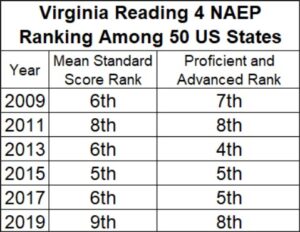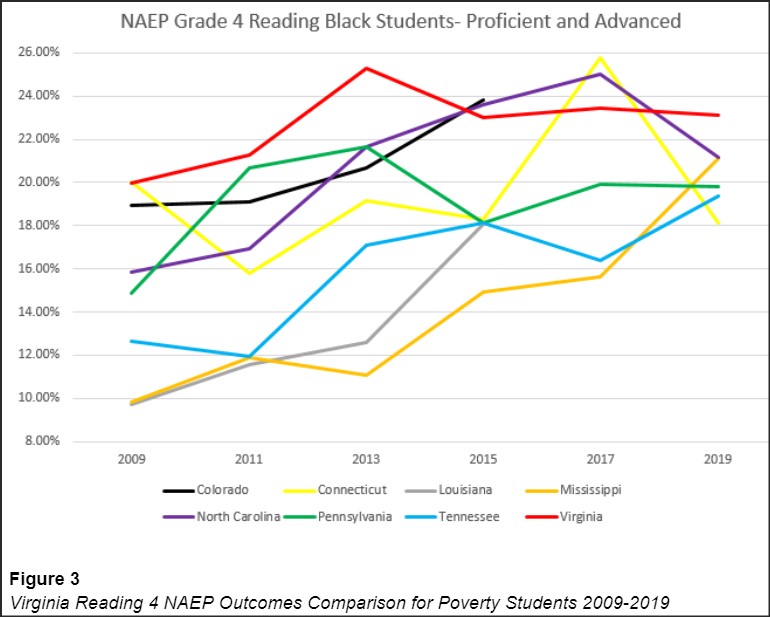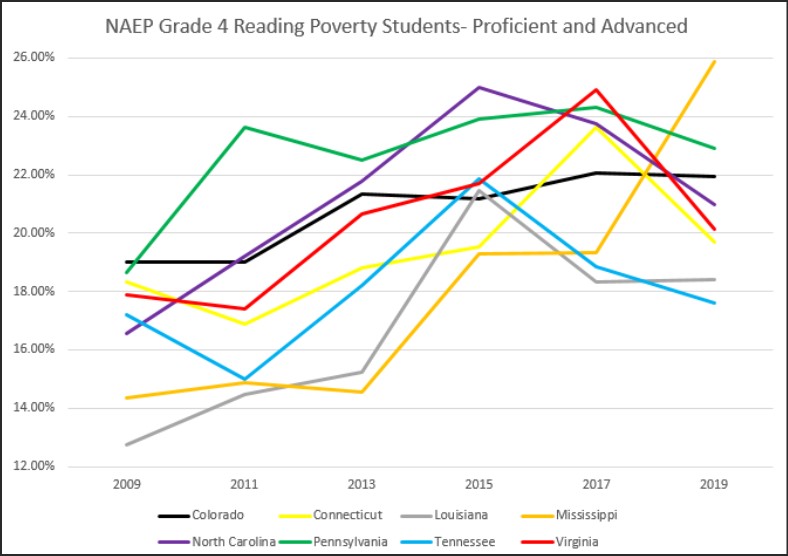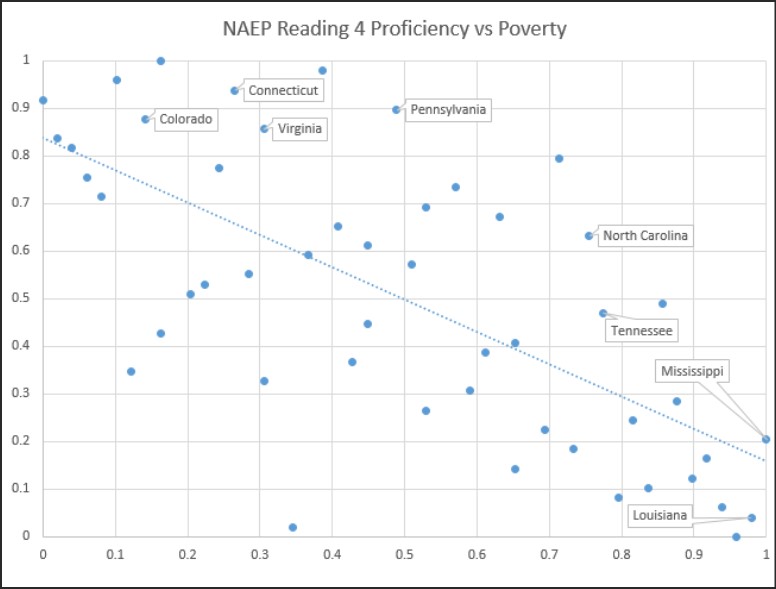 by Matt HurtOn January 29, the Richmond Times-Dispatch published an op-ed written by the patrons of HB319 and SB616 (The Virginia Literacy Acts). In this article, the legislators wrote that we must implement strategies adopted by other states if we wish to improve the reading abilities of our students. While there is always room for improvement, one should always consult the data to determine to what degree our process should change in order to realize that improvement. If you’re at the bottom of the heap, you probably should change your approach dramatically. If you’re one of the top performers, maybe subtle tweaks are the more reasonable approach.Consult the Data!When it comes to early elementary reading, the most relevant dataset we have to compare our performance in Virginia to those of other states is the Reading 4 NAEP test. When we consider our results relative to the other 49 states, it appears that Virginia as a whole has performed admirably. Given that Virginia has achieved near the top very consistently, it is not apparent that we should make radical changes to our statewide reading program.In the op-ed linked above, the legislators referenced the fact that a number of states had implemented the “Science of Reading” as proposed in the Virginia Reading Act. However, a comparison of Virginia’s reading outcomes to outcomes of those states does not suggest that it would be reasonable to follow their lead.
by Matt HurtOn January 29, the Richmond Times-Dispatch published an op-ed written by the patrons of HB319 and SB616 (The Virginia Literacy Acts). In this article, the legislators wrote that we must implement strategies adopted by other states if we wish to improve the reading abilities of our students. While there is always room for improvement, one should always consult the data to determine to what degree our process should change in order to realize that improvement. If you’re at the bottom of the heap, you probably should change your approach dramatically. If you’re one of the top performers, maybe subtle tweaks are the more reasonable approach.Consult the Data!When it comes to early elementary reading, the most relevant dataset we have to compare our performance in Virginia to those of other states is the Reading 4 NAEP test. When we consider our results relative to the other 49 states, it appears that Virginia as a whole has performed admirably. Given that Virginia has achieved near the top very consistently, it is not apparent that we should make radical changes to our statewide reading program.In the op-ed linked above, the legislators referenced the fact that a number of states had implemented the “Science of Reading” as proposed in the Virginia Reading Act. However, a comparison of Virginia’s reading outcomes to outcomes of those states does not suggest that it would be reasonable to follow their lead.


 In 2019, the relative poverty rates of states accounted for 47% of the variability in relative student outcomes in the NAEP Reading 4 assessment results. When controlling for this variable, Virginia still outperforms that general trend.
In 2019, the relative poverty rates of states accounted for 47% of the variability in relative student outcomes in the NAEP Reading 4 assessment results. When controlling for this variable, Virginia still outperforms that general trend. While there are some declines in the outcomes for Virginia students in 2019, it is important to note that there was no change in the state’s approach to reading in the years just prior to that. Several other factors could have had an impact, such as:
While there are some declines in the outcomes for Virginia students in 2019, it is important to note that there was no change in the state’s approach to reading in the years just prior to that. Several other factors could have had an impact, such as:
- Since approximately 2015, the Board of Education has pushed performance-based assessments and has been downplaying high- stakes assessments, primarily in History and Writing. However, the message received by many educators was that the SOL test is not a good measure of student outcomes in general.
- The Board of Education implemented a growth measure in the 2017 Standards of Accreditation which has been used for accreditation purposes. Many educators have stopped focusing on ensuring students are proficient since a student who demonstrates growth counts the same as a proficient student for school accreditation purposes.
The Real ProblemVirginia’s reading problem is not an overarching issue that affects every student, but rather localized pockets of underachievement. Overall, the state performs quite well. Some schools and divisions punch above their weight when considering the high rates of at-risk students they enroll and the very high achievement rates they produce. Other schools and divisions perform much less well. While there are achievement gaps among different subgroups of students in almost every school and division in the Commonwealth, those gaps are much more pronounced in some localities than others.One has to consider the possibility that the solutions proposed by the Virginia Literacy Act will disrupt schools and divisions that are already demonstrating high student achievement rates and low subgroup performance gaps (see General Assembly To Enlist in the Reading Wars?). Instead of fixing what ain’t broke in those schools and divisions, why not target those with the actual achievement problems?The most effective means by which to improve the outcomes for an organization is to improve the outcomes for the lowest performing operational units of the organization. I have personally witnessed this process in many divisions and schools that have made significant improvements in student outcomes. They didn’t ask folks who were already getting it done to change what they were doing. They gave those who were performing their reigns and let them run. These successful schools and divisions placed their entire focus on helping those who were struggling.In conclusion, instead of broadly sprinkling state dollars all over the state, why not focus those dollars where the need is the greatest and leave everyone else be? It is likely that the same amount of dollars widely distributed will have less impact on student outcomes than if they were concentrated where the need is the greatest.Matt Hurt is director of the Comprehensive Instructional Program based in Wise.

Leave a Reply
You must be logged in to post a comment.